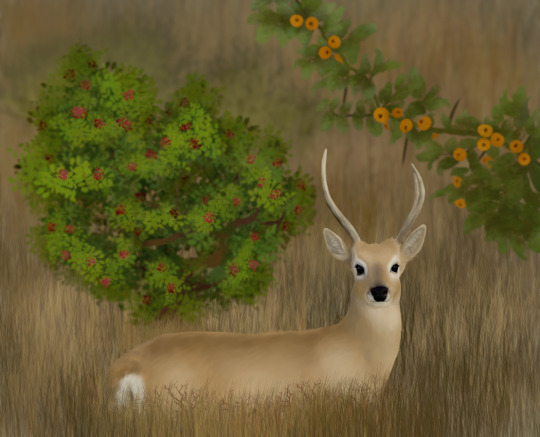#I am once again asking myself to finish prior to 3a - 4a
Explore tagged Tumblr posts
Text

Deercember Day Twenty-One: Pampas Deer | Holly and Hawthorn
The pampas deer (Ozotoceros bezoarticus), also known as veado-campeiro in Portuguese and as venado or gama in Spanish, lives in the grasslands of South America at low elevations, specifically across Brazil, Uruguay, Paraguay, Argentina, and Bolivia. Their common name is derived from the pampas (from the Quechua pampa, meaning "plain"), which are fertile South American low grasslands. It is the only species in the genus Ozotoceros. Their habitat includes water and hills, often with winter drought, and grass that is high enough to cover a standing deer. Many of them live in the Pantanal wetlands, where there are ongoing conservation efforts, and other areas of annual flooding cycles. Human activity has changed much of the original landscape. Pampas deer are among the most genetically polymorphic mammals: their current high nucleotide diversity shows that they had very large numbers in the recent past. They are known to live up to twelve years in the wild, longer if captive, but are threatened due to over-hunting and habitat loss. Many people are concerned over this loss, because a healthy deer population means a healthy grassland, and a healthy grassland is home to many species, some also threatened. Additionally, the pampas deer are very curious and like to explore; although this is endearing to observers, their lack of fleeing at the sight of humans makes them easier for poachers to kill. They will often stand on their hind legs to reach food or see over something. They are sedentary, with no seasonal or even daily migration. They usually feed regularly during the day, but sometimes have nocturnal activity. They may share their range with common crop plants including yerba mate (Ilex paraguariensis)—native to Brazil, Uruguay, Paraguay, and Argentina, and cultivated elsewhere—and tejocote (Crataegus mexicana), or Mexican hawthorn—native to Mexico and Guatemala, but has been introduced in the Andes and also cultivated elsewhere. Yerba mate is a plant species of the holly genus which is used to brew a caffeine-rich tea called mate when hot, and served cold alongside other components as tereré. Tejocote fruit is one of the most useful among hawthorns, and is consumed cooked, raw, and canned, or brewed into a hot fruit punch known as ponche. More information about pampas deer here, yerba mate here, and tejocote here.
References: Deer and Background, Holly 1, Holly 2, Hawthorn.
#I am once again asking myself to finish prior to 3a - 4a#least now I get to sleep forever because no work until TUESDAY#not that I work a whole lot but this lets me sleep in more#a little on the fence about my shading here but I got tired of fussing with it#the specific blur and focus on the plants makes up for it to me#as always‚ I am very proud to have found a range of species which could potentially coexist#Deercember#realHum#Art#Drawing#deer#deer art#pampas deer#veado-campeiro#venado#gama#Ozotoceros bezoarticus#Ilex paraguariensis#Crataegus mexicana
3 notes
·
View notes